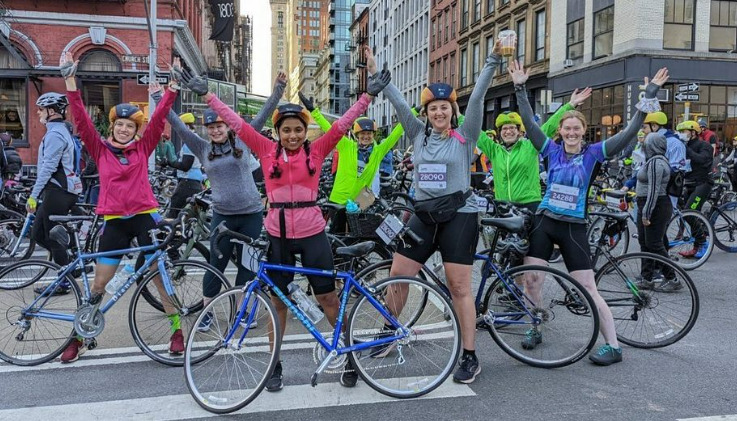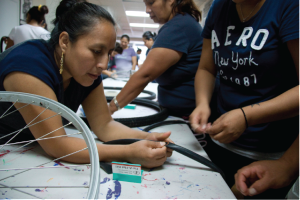By Maria Boustead
Happy New Year! Did you ring in the new year safely and joyfully and are you ready to make 2017 one of your best years ever? WE hope so!
I doubt I’m the only one reflecting on 2016 and making resolutions for the year ahead, which got me to wondering what bike-related goals people were setting for the new year, and how they were planning on accomplishing them. I put the question to several NYC women-focused bike groups on Facebook, including the WE Bike Female Bike Forum, Bicycle Habitat’s Women’s Cycling NYC, and Black Girls Do Bike NYC. Below are some of the things people are working towards, as well as resources for accomplishing them. WE hope that this will inspire you to set your own bike goals for 2017 and WE look forward to hearing about your progress and celebrating your achievements!
Complete a Century or Gran Fondo
Training for and completing a long ride is one of the most common bike goals people cite for 2017. Whether this is getting ready for a ride that you find daunting or just increasing your mileage and seeing some scenery, it’s a good idea to start training now and not waiting until the weather warms.
An indoor trainer, a device that converts your bicycle into a stationary bike, is helpful for training through winter. There are a lot of varieties of trainers on the market today; if the options seem overwhelming, read the “How to Choose an Indoor Bike Trainer” article in Bicycling Magazine for some clarity. Or, better yet, head to Bicycle Habitat’s upcoming “Rollers VS Trainers” clinic. Don’t have space or budget for a trainer? Taking regular spin classes is an alternative.
Once you have your trainer, find a training plan that suits your needs. This 8-week Training Plan for Riding a Century from Bicycling Magazine came recommended from people who’ve done it. Another suggestion is to consider joining the Century Road Club Association (CRCA) which comes with a season-long training program and access to the Club Races in Central Park.
When and where are these rides? These are some that people mentioned training for:
– Gran Fondo NJ
– Transportation Alternatives NYC Century
– Five Boro Bike Tour
– Ride to Montauk
– Rapha Womens 100k
Bike Packing, Touring, and Adventure Cycling
If you long for the freedom of the open road and/or like to get outdoors and into nature, bike packing and touring might be the perfect thing for you to try this year. Blackburn’s Out There website is full of inspiration and good resource, while 718 Cyclery in Brooklyn’s Women’s Cycling Adventure Group is our local go-to resource for all things adventure cycling. Check their website for their 2017 calendar of trips and classes, and their Facebook page is a great resource for discovering spots to go, gear reviews, and just meeting fellow bike adventurers.
Commuting By Bike More Regularly
How often did you bike to work last year? Using your bike to commute to work is a great way to get regular exercise, have more control over the time it takes to get from A to B, and a great way to get to know the city. So, set a goal for 2017 that increases that amount you ride, whether that’s once per work or four days per week. Resolve to ride when the temperature is above Xº or ever day that’s dry or even on days that are a little wet.
Need some guidance for city riding or riding in less-than-ideal weather? Check the WE Bike blog for posts about biking in cold weather, and Bike NYC for classes on Bike Commuting and Citi Bike Street Skills. Have more questions? Post them in the Facebook Female Bike Forum so your fellow bike commuters can weigh in.
Learning Bike Maintenance Skills
We’re blessed with having a lot of great bike shops in our city but it’s good to know how to do some basic maintenance and repairs on your own. One of the most commonly mentioned thing to learn was how to fix a flat, a crucial skill particularly if you’re riding outside of town.
Many bike shops host fix-a-flat and bike maintenance workshops throughout the year — check the website or Facebook page of your nearby stores to see if they have anything coming up, or ask if they’d give you a private lesson. Bike New York also offers a plethora of skill-building classes, such as Bike Maintenance 101.
WE hope that this list inspires you to up your cycling game in 2017! Do you have a goal you’re working towards that WE didn’t include here? The conversation is still going on Facebook – post your plans today!

